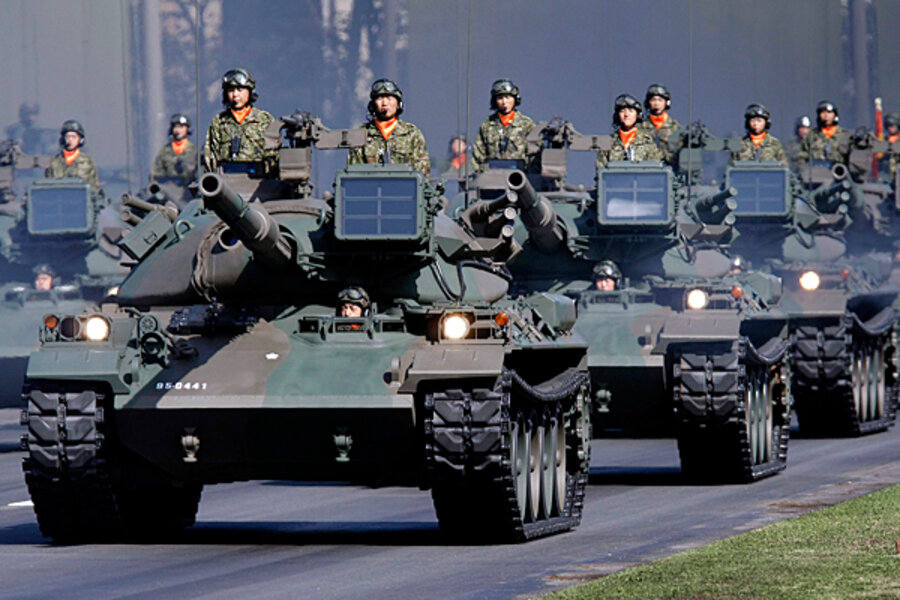Japan's new defense policy reflects growing concern about China
Loading...
| Tokyo
Japan should refocus its defense strategy on the rise of China and not on the cold war threat of Russia, according to new guidelines announced Friday.
The guidelines, which were approved by the Cabinet, also call for a stronger alliance with the US – Japan's biggest ally – and expanded security networks with partners like South Korea and Australia.
Japan will acquire new submarines and fighter jets, upgrade its missile defense capabilities and make its ground forces more mobile so that they can quickly respond to emergencies in southwest Japan.
While Japan has forces for self-defense, its pacifist constitution, drafted by the US after Japan's defeat in World War II, bar it from sending troops into combat overseas.
The guidelines paint China as a bigger threat than Russia and say Japan is shifting its defense emphasis from the northern island of Hokkaido to islands in the south, such as Okinawa and territories claimed by both Tokyo and Beijing that have recently led to diplomatic tensions.
Defense Minister Toshimi Kitazawa said the plan will help Japan adapt to a "new, complex security environment."
China immediately slammed the guidelines as "irresponsible."
The Japan-US alliance remains "indispensable" to Japan's security, the statement said, calling for stronger cooperation between Japanese and the 47,000 US armed forces based in this country.
But it also noted a relative decline of America's strength and rise of emerging countries such as China and India. Japan, meanwhile, should pursue its own efforts to enhance missile defense capabilities to protect itself from threats by China and North Korea, it said.
"We still have lots of tanks and Ground Self-Defense Forces on Hokkaido and we need to shift to the southwestern islands," a senior government official said on condition of anonymity before the official release of the guidelines. The official said the goal is to "modernize our defense posture from our cold war days."
The new strategy document also said North Korea's military activity is a "pressing and serious destabilizing factor" for Japan and causes grave problems for international nonproliferation efforts.
"The Korean Peninsula and North Korea are imminent and concrete threats to Japan, while China is more of a medium-term threat," said Hideshi Takesada, executive director at the National Institute for Defense Studies.
In Beijing, officials said Tokyo was wrong in seeing China as a threat.
China insists on following the "road of peaceful development" and upholds a military policy that is entirely defensive in nature, Foreign Ministry spokeswoman Jiang Yu said.
Relations between Tokyo and Beijing deteriorated quickly over a long-standing dispute over islands in the East China Sea called Diaoyu in China and Senkaku in Japan after a Sept. 7 collision between a Chinese fishing boat and Japanese coast guard vessels, an incident that has raised public and government concern over China's military strength.
Washington has urged Japan to play a greater security role in the region, and proposed a three-way military alliance that would include South Korea.
Regarding specific deployments, Japan plans to send more ground troops to its southwestern islands. The troops will use mobile radar and fly reconnaissance aircraft to monitor the surrounding seas.
The plan did not specify the location but Japanese media have said 100 ground troops will be sent to Yonaguni, in Okinawa prefecture, where Japan currently has no troops. Placing them on the island that is closer to China, Taiwan and the disputed islands could be contentious.
Japan will also increase its submarines to 22 from the current 16 and add a destroyer, bringing the total fleet to 48. The cash-strapped government will keep the budget for the next five-year defense plan roughly unchanged at 23.5 trillion yen ($280 billion).
AP writers Christopher Bodeen in Beijing and Eric Talmadge in Tokyo contributed to this report.





